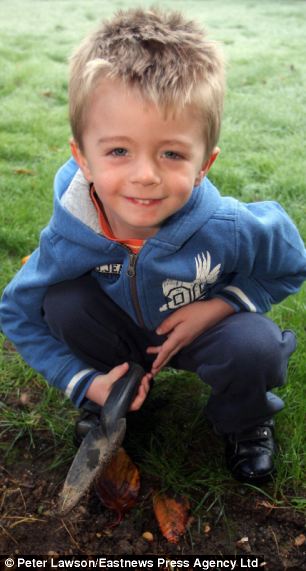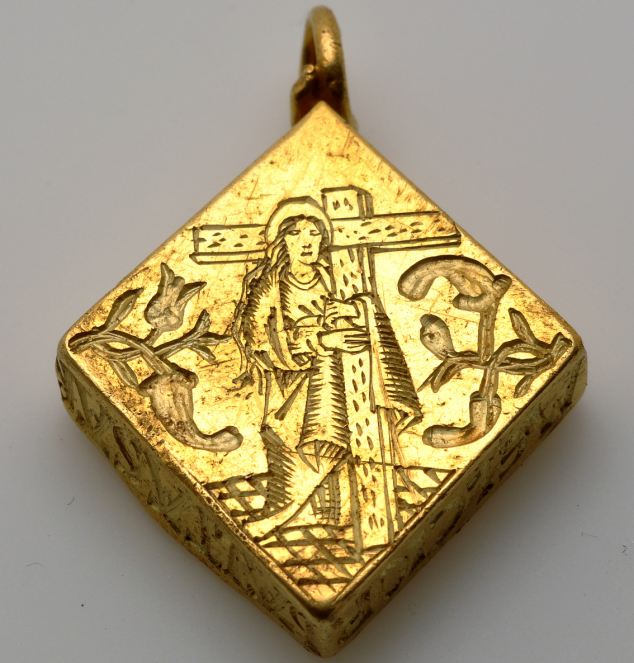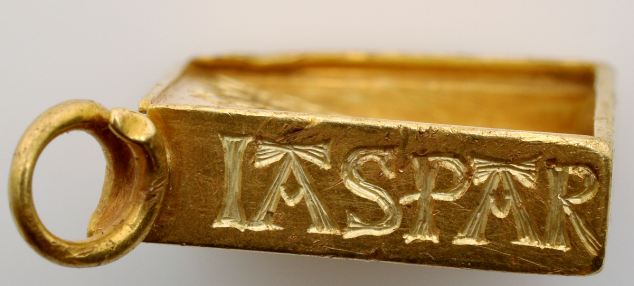A 3 year old boy using a metal detector for the first time found a 500 year old gold locket worth £2.5 million.
James Hyatt, who has now reached the grand old age of four, was metal detecting with his father and grandfather in a field in Hockley, Essex, last year when the metal detector began to buzz.
What he found was a gold container - a reliquary - from the reign of Henry VIII, which was used to hold religious relics, such as supposed splinters of wood from Jesus's cross. The front is engraved with an image of the Virgin Mary clutching a cross while the back has five bleeding hearts. It may have belonged to a member of the Royal Family.
The reliquary has been declared treasure trove at an inquest, meaning the proceeds of its sale will be shared between James’s family and the landowner.
Boy, 3, unearths £2.5m treasure trove on FIRST metal detecting expedition
By Andrew Levy
17th November 2010
Daily Mail

Lucky Jim: Four year old James Hyatt discovered a 16th century gold pendant
IF James Hyatt was old enough to understand the concept, his family would tell him he is blessed with beginner’s luck.
The three-year-old was minutes into his first ever attempt at metal detecting when he found a gold locket potentially worth £2.5million.
He had just been passed the device at a field in Hockley, Essex, when it began to buzz.
Buried 8in below was a reliquary.
This is a gold container used to hold religious relics – items believed to be the remains of religious figures or objects associated with them.
Experts have dated the locket to the early 16th century – the era of Henry VIII – and say it could have belonged to a member of the royal family.
The reliquary has been declared treasure trove at an inquest, meaning the proceeds of its sale will be shared between James’s family and the landowner.
James’s father Jason, 34, said: ‘My son is one of the luckiest people ever.
‘If we go to the doctors he’ll put his hand down the side of the sofa and pull out a tenner.’
James, who is now four, was on a metal detecting trip with his father and grandfather in May last year when he asked to try using the equipment.
His father, a web designer who lives with his wife Rebecca, James and six-month-old daughter Emily in Billericay, Essex, added: ‘After about five minutes we got a buzz and we started digging.
‘James was so excited when he realised he had found real treasure. Dad was blown away.
'In 15 years doing it as a hobby I'd never found anything like it. If we get any money it will be for the children.’

Worn by royalty: The rare 16th century gold reliquary pendant, which was used to hold religious relics

Named: Caspar is misspelled on the item but the engraving is of a type popular in the 16th century
James said: ‘I was holding the detector and it went beep, beep, beep. Then we dug into the mud. There was gold there. We didn’t have a map – only pirates have treasure maps.’
The sides of the reliquary are about an inch long and it is 73 per cent gold.
The front is engraved with an image of the Virgin Mary clutching a cross while the back has five bleeding hearts.
Only three other reliquaries of this type are known to have survived.
James’s find will be valued and then offered for sale to institutions including the British Museum.
dailymail.co.uk
James Hyatt, who has now reached the grand old age of four, was metal detecting with his father and grandfather in a field in Hockley, Essex, last year when the metal detector began to buzz.
What he found was a gold container - a reliquary - from the reign of Henry VIII, which was used to hold religious relics, such as supposed splinters of wood from Jesus's cross. The front is engraved with an image of the Virgin Mary clutching a cross while the back has five bleeding hearts. It may have belonged to a member of the Royal Family.
The reliquary has been declared treasure trove at an inquest, meaning the proceeds of its sale will be shared between James’s family and the landowner.
Boy, 3, unearths £2.5m treasure trove on FIRST metal detecting expedition
By Andrew Levy
17th November 2010
Daily Mail

Lucky Jim: Four year old James Hyatt discovered a 16th century gold pendant
IF James Hyatt was old enough to understand the concept, his family would tell him he is blessed with beginner’s luck.
The three-year-old was minutes into his first ever attempt at metal detecting when he found a gold locket potentially worth £2.5million.
He had just been passed the device at a field in Hockley, Essex, when it began to buzz.
Buried 8in below was a reliquary.
This is a gold container used to hold religious relics – items believed to be the remains of religious figures or objects associated with them.
Experts have dated the locket to the early 16th century – the era of Henry VIII – and say it could have belonged to a member of the royal family.
The reliquary has been declared treasure trove at an inquest, meaning the proceeds of its sale will be shared between James’s family and the landowner.
James’s father Jason, 34, said: ‘My son is one of the luckiest people ever.
‘If we go to the doctors he’ll put his hand down the side of the sofa and pull out a tenner.’
James, who is now four, was on a metal detecting trip with his father and grandfather in May last year when he asked to try using the equipment.
His father, a web designer who lives with his wife Rebecca, James and six-month-old daughter Emily in Billericay, Essex, added: ‘After about five minutes we got a buzz and we started digging.
‘James was so excited when he realised he had found real treasure. Dad was blown away.
'In 15 years doing it as a hobby I'd never found anything like it. If we get any money it will be for the children.’

Worn by royalty: The rare 16th century gold reliquary pendant, which was used to hold religious relics

Named: Caspar is misspelled on the item but the engraving is of a type popular in the 16th century
James said: ‘I was holding the detector and it went beep, beep, beep. Then we dug into the mud. There was gold there. We didn’t have a map – only pirates have treasure maps.’
The sides of the reliquary are about an inch long and it is 73 per cent gold.
The front is engraved with an image of the Virgin Mary clutching a cross while the back has five bleeding hearts.
Only three other reliquaries of this type are known to have survived.
James’s find will be valued and then offered for sale to institutions including the British Museum.
dailymail.co.uk